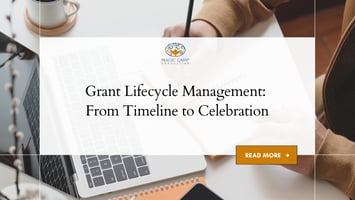For many nonprofits, grants are a lifeline. They provide essential funding for programs, staff, and...
Multi-Year Grants: How to Propose and Manage Long-Term Funding

Nonprofit leaders often find themselves in a cycle of scrambling for funding year after year. One-year grants can be helpful, but they rarely provide the long-term security organizations need to build, grow, and sustain impact. That’s where multi-year grants come in.
Multi-year funding gives your nonprofit the breathing room to plan strategically, retain staff, and focus on mission-driven work instead of constant fundraising. But winning these grants and managing them well requires a different approach.
At Magic Lamp Consulting, we help organizations strengthen their readiness, propose with confidence, and manage long-term grants strategically. Below, we’ll walk you through how to position your organization for multi-year funding, pitch persuasively, and manage those grants to ensure future renewal.
1. Demonstrate Organizational Readiness
Funders are more likely to invest in multi-year grants when they believe your organization can sustain the work and their investment over time. That means showing that you have the infrastructure, leadership, and systems in place to manage funds responsibly and achieve results.
What to Show:
- Strong financial systems and controls
- Stable leadership and staffing
- Clear strategic goals
- A track record of meeting past grant objectives
Action Step: Conduct a “grant readiness audit” of your internal operations, finances, and outcomes reporting. Address any weaknesses before applying for multi-year funding.
2. Tell a Long-Term Impact Story
Single-year grants often focus on short-term outputs. Multi-year grants are different. Funders want to know: What will change over the next 2–5 years because of our investment? Your proposal should include a vision for growth, sustainability, or deepening impact over time.
Include in Your Pitch:
- A clear theory of change
- Milestones for each year of the grant
- How success will be measured at different stages
- How the program will evolve or scale
Action Step: Use a visual timeline or roadmap in your proposal that outlines year-by-year goals and anticipated outcomes.
3. Build a Relationship, Not Just a Proposal
Funders awarding multi-year grants are looking for partners, not just grantees. That means relationships matter. Don’t just submit a proposal cold. Engage the funder in conversation ahead of time, ask thoughtful questions, and align your goals with their strategic priorities.
Pro Tip: If a funder doesn’t currently offer multi-year grants, don’t be afraid to ask if they’d consider a multi-year commitment for the right fit, especially if you can show a strong need and long-term vision.
Action Step: Identify one or two funders you’d like to pursue for multi-year grants and begin engaging them now, well before your next application.
4. Manage the Grant With Precision and Transparency
Winning the grant is only half the battle—keeping it (and potentially renewing it) is just as important. Multi-year grants typically come with annual benchmarks and reporting requirements. Clear, timely communication builds trust and sets the stage for future funding.
Best Practices:
- Set internal calendar reminders for reporting deadlines
- Hold quarterly check-ins with program staff to review progress
- Track outcomes and spending in real-time
- Share both successes and challenges with the funder
Action Step: Create a grant management plan for each multi-year grant you receive. Include deadlines, metrics, responsible staff, and reporting tools.
5. Plan for Sustainability From Day One
Even the best multi-year grants eventually end. Funders want to know that their investment will leave a legacy. Include a sustainability plan in your proposal that outlines how you’ll fund and maintain the program after the grant period ends.
Include:
- Diversification of revenue streams
- Capacity-building strategies
- Strategic partnerships that extend impact
- Earned income or other funding plans
Action Step: In your proposal, dedicate a section to sustainability that’s practical, not vague. Show funders that their investment won’t vanish after year three.
Our Final Thoughts
Multi-year grants are transformative—but they require clarity, discipline, and vision. The funders who make long-term commitments are looking for organizations that treat their support as a true partnership. When you approach these opportunities with confidence and preparation, you can unlock stable, predictable funding that allows your team to focus on what really matters: your mission.


.png?height=200&name=Avoiding%20the%20Grant%20Trap%20Common%20Mistakes%20Nonprofits%20Make%20(and%20How%20to%20Fix%20Them).png)
